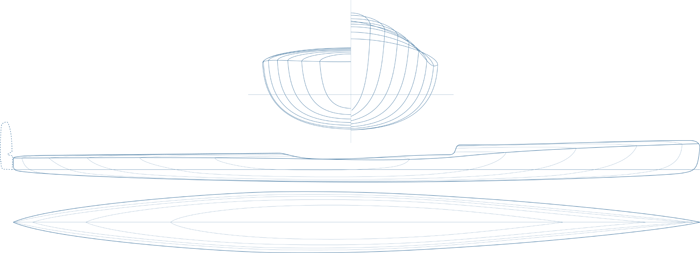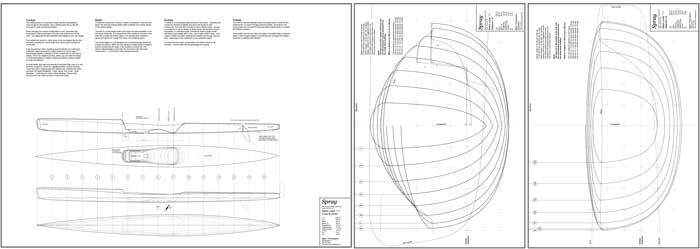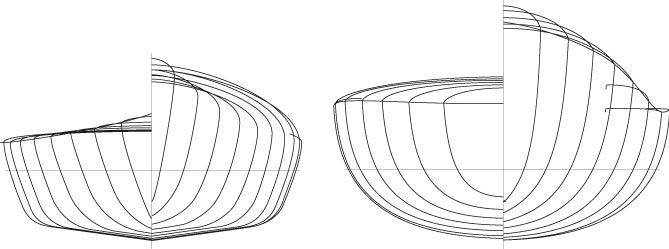Spray
Latest updated Saturday, January 4, 2025, 58 comments
Images | Particulars | More about | Background and history
Plans, Spray - 166 EUR
Purchase
Spray, designed in 2014, is a shorter, wider, and more initially stable surfski version of Spindrift– for those who would sacrifice a little top speed for stability. Anyone used to sea kayaks can paddle Spray, and enjoy the speed, handling in waves, and surfing capabilities. It may take a short while to get used to the open cockpit instead of being squeezed in between back, thigh, and foot supports.
Take a look at Roger Karlsson's photo diary (Swedish only) from his Spindrift project,
or dive into Jose Francisco Yuste Ramirez' very ambitious Spray project.
or Per Carlins building pages with discussions on material and methods (Swedish only).
More stability?
After a couple of requests for even more width/stability, I have prepared an alternative station drawing, with 54 cm beam (the same beam as fx Epic V8). If this is what you want please note "wide" in the alternatives field when ordering. On the lines and construction drawing the cockpit is 2 cm wider, but apart from that unchanged – other dimensional changes must be done individually by the builder if necessary. But you should weight 90 kg or more, or always paddle with a touring load to choose "wide" – otherwise, you will float too high and lose stability through higher CG and less waterline width.
Particulars

| Length¹ |
560/556 cm (overall/WL) |
| Beam |
50/46 cm (overall/WL) |
| Draft |
11 cm |
| Cockpit¹ |
132x40 cm |
| Height¹ |
31/23 cm (in front of/behind the cockpit) |
| Weight² |
15-18 kg |
| Displacement/volume⁶ |
110 kg/374 litre |
| Speed³ |
8.7/12.8 km/h |
| Prismatic coefficient |
0.54 |
| Wetted surface |
1.97 m² |
| Drag⁴ |
1.28/2.32 kp |
| Stability⁵ |
3/4 (initial/secondary stability) |
| Intended use |
Motion och långfärd till havs och i sjösystem |
| Length¹ |
560/556 cm (overall/WL) |
| Beam |
54/50 cm (overall/WL) |
| Draft |
11 cm |
| Cockpit¹ |
132x42 cm |
| Height¹ |
31/23 cm (in front of/behind the cockpit) |
| Weight² |
15-18 kg |
| Displacement/volume⁶ |
118 kg/400 litre |
| Speed³ |
8.6/12.6 km/h |
| Prismatic coefficient |
0.54 |
| Wetted surface |
2.11 m² |
| Drag⁴ |
1.29/2.36 kp |
| Stability⁵ |
4/4 (initial/secondary stability) |
| Intended use |
Motion och långfärd till havs och i sjösystem |
* These dimensions can be adapted to suit personal needs or wishes.
** Depending on type of wood, equipment, care with epoxy usage, sanding etc. etc.
*** The speed numbers are based on mathematical standard formulas (175 lb paddler + 30 lb carco weight) and corrected from the kayaks actual performance om trials, on tours and in races.
⁴ Calculated resistance in 4 and 5 knots (at nominal load capacity).
⁵ Initial stability and secondary stability on a subjective scale, where 1 is very tippy and 5 is very stable.
⁶ Displacement is kayak + paddler + load. Count off the kayak weight to get the load capacity.
Plans
The plan sheets contain the information needed to build the kayak/canoe. Station molds, stems and construction details are full scale. For kayaks the recommended cockpit size is shown half scale with offsets for a full scale drawing and advice on altering the size. On the plans you will also find advice on how to shorten or lengthen the craft. Lines and construction drawings are in metric scale 1:10.

 The illustrated step-by-step building manual is in Swedish only, but it is available online in English: it covers all steps in detail and will guide first-time builders through the project.
The illustrated step-by-step building manual is in Swedish only, but it is available online in English: it covers all steps in detail and will guide first-time builders through the project.
Plans, Spray - 166 EUR
Purchase
Minimum window dimensions to get your kayak out from the workshop:
51x35cm
Why a surfski instead of a sea kayak?
There are of course good reasons for both. They do the same job and there is not much that cannot be done in both. I think that surfskis will take over some of the sea kayaks' territory. Perhaps we will declare rudder-dependant sea kayaks, multisport kayaks, and training kayaks to be 'endangered species' in a few years? Surfskis can be considered a step forward as a kayak concept. Consider the following:
Safety
The safety routines in a ski are easier to master than comparable routines in a sea kayak.
- Reentering the cockpit from the sea is a straightforward and quite simple procedure that takes a couple of seconds and is made the same way in all conditions. Since it is very quick, there is less risk of getting cold or tired, and there is no need to pump – with no deck, most of the water splashes out when entering and the rest drains as soon as you start paddling.
- A surfski is basically a simpler craft with fewer components that can break or malfunction, and the few which need adjustment – the pedal setup and the drain – are within reach in the cockpit.
- A surfski is an efficient craft; fast and light – but it is not just about speed. Just as important is conserving energy, whether long-distance touring or racing and still having the strength to deal with a headwind or adverse current at the end of the day.
- A surfski is controllable in conditions where a sea kayak is hard to control. The reason is efficient steering: solid pedals and big efficient rudders (I never thought I would actually say that ;-). An elliptical rudder two or three feet from the stern on a highly maneuverable surfski is far more efficient than a stern-mounted rudder on a sea kayak, and the surfski’s solid and precise pedal control with no flex is much better than the rudder arrangement on most sea kayaks.
Fun to paddle
A surfski is exciting on the water. In addition to all that most sea kayaks can do, the surfski offers downwind runs in rough seas with amazing surfing under full control and at speeds well above what even a very fast kayak can achieve. With a surfski, a paddler can play in breaking waves the same way as a board-surfers do.
Simple to use
The surfski invites a minimalistic approach: fewer gadgets to buy, pack and unpack during trips, and less upkeep. That leads to less weight, better performance, and quicker launchings.
Exercise
A surfski is an excellent exercise and training craft. Of course, a sea-kayak can provide an efficient workout – provided you don’t slouch against the backband and arm-paddle – but the surfski’s simplicity makes it easy to get on the water. Head for the shore with the light surfski on one shoulder, paddle, and PFD in hand launch and away you go...
Sea racer or surfski?
What is the real difference between a fast kayak (Sea Racer) and a surfski (Spindrift, Spray)? What separates surfskis from sea kayaks or multisport kayaks?
The only sure identifier is the cockpit configuration. In everything else there are lots of crossover boats floating around, defying categorization: sea kayaks with surfski maneuverability and surfski with the calm movements of sea kayaks and a variety of hull configurations.
Surfskis were developed to run off the wind on large swells at high speed and to surf wavefronts in control. To maintain position and direction on those waves, extreme maneuverability was needed, and this required precise steering and a relatively large rudder. The high-volume bow prevented diving in the gigantic waves of the surfski’s native waters in Hawaii, South Africa, California, and Australia. Meanwhile, the stern often became little more than a long tail with a rudder. The fore part was deep and narrow moving the center of the lateral area forward to balance the large rudder while the aft part was wide and shallow to prevent the stern from submerging at speeds close to or above hull speed. From tools for elite paddlers in tough ocean races, surfskis have evolved to include craft more suited to "normal" paddlers with fast-touring ambitions.
In contrast, sea kayaks for touring have evolved towards strong tracking, rather than maneuverability. Designers have sacrificed some maneuverability for comfort on long passages. In automotive terms, they have the soft, somewhat imprecise steering with a healthy margin for errors of a family car, rather than the precise and attention-demanding steering of a race car. Of course, some control is lost in the process. If you have tried to surf a steep wave diagonally in a typical sea kayak, you will know what I am talking about. But lately, we have seen a lot of sea kayaks with almost surfski-like maneuverability and control.
A look at the lines of the Sea Racer and Spindrift/Spray reveals these differences. The Sea Racer hull is more symmetric, with LCB, LCF, and CLA quite close to the center, characteristic of a hull that moves smoothly and predictably in the water (LCB = Longitudinal Center of Buoyancy = the centroid of the underwater volume of the boat expressed as a longitudinal location. LCF = Longitudinal Center of Flotation = center of the waterplane, the "seesaw" pivot of the craft. CLA = the geometric center of the lateral plane). The seat is located slightly aft of the center, providing controllability without being overly dependent on the rudder (mildly understeering in automotive terms). There is not much rocker, which improves tracking. The kayak deck with cockpit rim for the paddler’s spraydeck keeps water out, allowing for a lower and less wind sensitive profile. For the same reason, the freeboard amidships can be lower, to allow a lower and less tiring paddle stroke on touring.

In the surfski, the CLA is moved forward to balance the large rudder. The seat position slightly forward of the LCB is the key to the efficient and precise steering on wavefronts – in automotive terms the ski is slightly oversteered at low speeds, but steering becomes neutral at higher speeds since the longitudinal position of the hull's center of turning is related to speed.

Note that the Sea Racer is not a typical sea kayak – it was influenced by surfskis from the start.
The station's sections show that the surfski is wider and higher than a kayak like Sea Racer. But the difference in volume and load capacity is not as large as it might seem – the higher Cp of the Sea Racer means that the volume is more evenly distributed along the hull while the surfski has more volume concentrated amidships. This suggests that the Sea Racer-type kayak should be slightly faster on flat water, but the surfski should win in waves.

The shapes of the sections look quite different. In the Sea Racer, I wanted to optimize the initial stability in what is a very narrow craft (43 cm), with the chines also enhancing steering control when the hull is leaned (a way to keep rudder turbulence to a minimum). For the wider surfski, I chose to minimize friction with elliptical sections below the waterline.
Software and the design process
The sectional shape is also to a degree influenced by different calculation algorithms. The Sea Racer was developed using Bearboat software by Robert Livingstone for the hydrodynamic calculations. The main advantage of this is that the underbody-defining vectors hang from the waterline and the keel, which makes it possible for the software to minimize the wetted surface for every set of design parameters chosen. It saves a lot of time fine-tuning the hull to low friction, but it also means that the bottom and freeboard are two independent sets of curves, meeting at the waterline. On certain kinds of hulls, this complicates getting a smooth natural curve from the sheer to the keel.
For the surfski, I used Ross Leidy's KayakFoundry software, forked from Bearboat, but with one important difference: the vectors hang from the sheer and the keel. That allows better overall control of the lines (including the shape of the deck, stem, and stern) compared to Bearboat. The disadvantage is that you have to work out the wetted surface manually, based on experience, with repeated calculations and checking. For me, a further disadvantage is that KayakFoundry is Windows-only software. I have to run it virtualized in Parallels on my iMac. It works but is a bit slower than Mac applications.
Both Bearboat and Kayak Foundry are easy to use and do an excellent job at their level, but the downside of their simplicity is their many limitations (these are not a problem for the amateur builder, who would solve those issues in the construction phase rather than on the computer anyway). Therefore, I use them for quick zooming in on the hull shape I want, along with all the hydrodynamic data I need – getting within 95% of the final design in a surprisingly short time and with adequate accuracy. From there, I transfer the lines to Illustrator for the final manual fine-tuning, including both functional tweaking and the visual layout of lines and surfaces – which normally takes more time than the first 95% in the design software!
That may seem a tedious way to design a kayak, but the alternative – professional ship CAD design systems are very expensive and bloated with features of which I would use a small percentage (I do not need to know what happens to the ship's stability when 600 tons of crude oil sloshes around in a half-empty tank, nor at which parameters the risk of propeller cavitation becomes an issue ;-) and would take hundreds of hours training for me to master.
Spray
The surfski is named Spray – seemed a good name for a younger sibling to Spindrift.

Surfski history
Surfski history appears not to have been written yet, at least in a way that most can agree upon. The following is what I have found here and there on the internet. The history seems linked with surfboards rather than with kayaks. One common starting point is two brothers in Australia, Harry and Jack McLaren, who were using a kind of paddleboard a hundred years ago in the breakers around the family-owned oyster beds at Port Macquarie, New South Wales. From the contemporary descriptions, though called surfskis, these were the real ancestors of today’s surfboards and SUPs rather than the modern surfski.
Sometime in the middle of the 20th century, the rescue organizations in Australia realized that these 'surfskis' were more efficient than the 5-man rowboats that were used to save swimmers swept out to sea by the currents. They were simpler, cheaper and faster, and 1946 'surfskis' were officially accepted as rescue craft – though they were flat surfboards, far from the surfskis of today.
What now is known as surfskis, were developed in competitions between rescue teams from different beaches during the 1950s. The early paddleboards were heavy skin-on-frame designs, but they soon evolved to longer and narrower hulls – still paddled standing up as SUP:s.
At the Melbourne Olympics 1956, athletes from other countries saw the surfboards and were impressed – and the surfski paddlers discovered the efficiency and power when sitting down with a kayak paddle. In the US and South Africa, the next steps in the development of the modern surfski were taken.
In South Africa, the skin-on-frame evolved into foam-filled fiberglass hulls with a cockpit and the main focus was distance competition. In Australia, the sport came to focus on sprint racing in strictly regulated fiberglass surfskis.
In Hawaii, this evolution took off a little later and, very interestingly, without any rules regarding the hulls. The Hawaiian environment was the toughest possible: formidable Pacific swell and fast-moving currents around and between the islands. The Molokai Race became the most important event to evaluate new designs and ideas. It’s very interesting that the record time for the Molokai Race was set by Dean Gardiner in 1997, using an older, shorter, and heavier Hawaiian ski and a standard flat paddle. That’s just one indication that today’s 6.5m surfskis may be longer than necessary. These longer hulls may have been developed to suit a few big, strong competitors who dominated surfski racing, and who could drive the longer hulls to higher speeds in spite of the increased friction from the larger wetted area. But, are these longer hulls the best for us?
I believe that the top surfskis of tomorrow will be perhaps 5% shorter.

